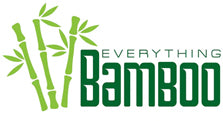Bamboo is a very fast growing, renewable and easy-to-grow resource. It is an extremely versatile material with countless uses including construction, clothes, food and fuel.
There are over 1000 species of bamboo. It is a type of grass and grows from it’s roots, when it is cut it quickly grows back with most species maturing in 3-5 years. This amazing plant grows in both tropical and temperate environments and is very hardy, not needing pesticides or herbicides to grow well.
Some facts about the sustainability of bamboo are:
- It requires no pesticides or chemical fertilisers
- It grows rapidly and can be harvested in 3-5 years
- It rarely needs replanting
- It produces more oxygen than trees
- It plays an important role in the balance of oxygen and carbon dioxide in the atmosphere
- It sequesters carbon dioxide and is carbon neutral
- It requires no irrigation
- It is excellent for inhibiting soil erosion
- It grows in a wide range of environments
- Its production into fibres has lower environmental impact than other forms of fibre, especially synthetic ones.
The uses of bamboo
Houses, schools and other buildings
Today, over one billion people in the world live in bamboo houses. According to UNESCO, 70 hectares of bamboo produces enough material to build 1000 houses. If timber was used instead, it could require the felling of trees from an already diminishing forest.
Roads and bridges
It is being used in road reinforcements in India and it is also used in bridges built in China and is capable of supporting trucks that weigh as much as 16 tons.
Medicines
In China, ingredients from the black bamboo shoot help treat kidney diseases. Roots and leaves have also been used to treat venereal diseases and cancer. According to reports in a small village in Indonesia, water from the culm (the side branches) is used to treat diseases of the bone effectively.
Clothes
It’s the new hemp, it can be made into a strong and durable fabric a bit like canvas and can be made into all sorts of clothes. Additionally, bamboo fabric is breathable, thermal regulating, wicks moisture better than polyester performance fabrics, will resist odour and is absorbent and fast drying keeping you dryer and more comfortable than any cotton or polyester fabrics. Beware though: it is also made into Rayon in a chemical process that is unsustainable.
Accessories
It is also used to make necklaces, bracelets, earrings, and other types of jewellery.
Food
Shoots are used mainly in Asian food preparations. In Japan, the antioxidant properties of the bamboo skin prevent bacterial growth, and are used as natural food preservatives.
Fuel
Charcoal made from this amazing plant has been used for centuries as cooking fuel in China and Japan. The Bamboo vinegar or pyroligneous acid is extracted when making charcoal and is used for hundreds of treatments in almost all fields. This liquid contains 400 different chemical compounds and can be applied for many purposes including cosmetics, insecticides, deodorants, food processing, and agriculture.
Scaffolding
It is often used for scaffolding because it proves to be an eco-friendly and cost-effective resource. In Hong Kong, bamboo scaffolding is preferred over metal scaffolding because its easily available and cheaper.
Furniture
Beautiful and intricately crafted beds, chairs and tables are made from bamboo. Read more about sustainable furniture here»
Rugs and textiles
Exotic woods like the mango are often used in Oriental rugs. Buying a bamboo rug will ensure that you save a tree.
Paper
Pulps are mainly produced in China, Myanmar, Thailand and India, and are used in printing and writing papers.
Nappies
According to Japanese scientists, bamboo cloth can retain its antibacterial quality even after 50 washings.
Utensils and tableware
Cups and saucers, spoons and ladles can all be made from this incredibly versatile material.
The list is endless…
Musical instruments, fishing rods, bicycles, helmets, toys…


